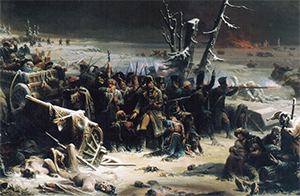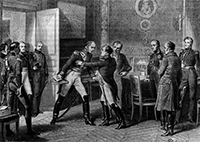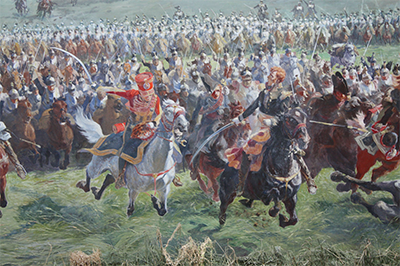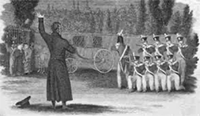French Marshal Michel Ney
Part 2: Grand Designs, Grand Defeats In April 1812, Ney took over the Ⅲ Corps of La Grande Armée and led it into Russia, along with hundreds of thousands of other French and allied soldiers in what has come to be called the Moscow campaign. Ney was wounded again, in a battle at Smolensk, this time in the neck. Finding it nothing much to worry about, he carried on and, donning full dress uniform, led his men in the fierce fighting that punctuated the Battle of Borodino. 
That proved to be the one bright spot for Ney and for Bonaparte in the Moscow campaign. Once the emperor–seeing Moscow itself burning and all hope of a note of surrender from the Russian Tsar gone–ordered a retreat, the Russians harried that retreat and Ney and his men had to rescue Marshal Louis-Nicolas Davout's rearguard from entrapment. Appointed the new head of the rearguard, Ney kept the Russian force at bay so that the remnants of the French army could escape from Russia. They crossed the frozen Dnieper River, Nay at one point pulling one of his men from the frozen water after the ice had broken. On another occasion, Ney grabbed a series of muskets and fired at the pursuing Russians. Many sources say that Ney was the last French soldier to leave Russia. Hearing that Ney and his men were still alive and uncaptured, Bonaparte declared Ney "the bravest of the brave." Ney spent a few months of peace and recovery and then rejoined the army in Germany, in March 1813, for the War of the Sixth Coalition. He fought in the French victory at Lützen, sustaining a gunshot wound to the right leg, and commanded the left wing of the army at two subsequent French victories, at Bautzen and at Dresden. He commanded four corps at the Battle of Leipzig, during which he sustained yet another injury, a shot in the left shoulder, and had two horses shot from underneath him. In the waning moments of that battle, when a botched explosives effort blew up a bridge too early and trapped French troops on the city-side of the river, Ney rode his horse across the river in order to escape. Ney was one of several of Bonaparte's marshals who convinced the emperor to abdicate, which he did on April 12, 1814. The new leader of France was King Louis XVIII, who allowed Ney to retain his rank, as marshal, and his two titles, bestowed on him by Bonaparte: He was Duke of Elchingen, so named for his victory at that place, and Prince of Moskowa, so named for his part in the victory at Borodino. Ney was not of noble origin, and neither was his wife. With the monarchy restored, the back-in-favor nobility found opportunities to remind Ney of his common upbringing, going so far as to exclude him from social gatherings despite his status as a military hero, and the marshal chafed at this discrimination. 
Nonetheless, Ney had taken an oath to the king and fulfilled that oath in March 1815 when he was ordered to bring in the resurgent Bonaparte as a prisoner. The former emperor had escaped his island prison of Elba and had landed near Calais with 1,000 loyal soldiers. As he marched to Paris, he gained many more followers. Ney, meanwhile, had been sent by the king with a force of 6,000 soldiers to arrest Napoleon and bring him back to Paris in an iron cage. The two forces met at Auxerre on March 18, and Ney abandoned his current instructions in order to take new ones from his former commander. The emperor's force moved on to Lyon, taking that city as well. By this time, the force numbered 15,000. King Louis XVIII had left Paris on March 13, and Bonaparte and his men arrived the following week. They had faced not a single shot fired in anger. By that time, the Congress of Vienna had declared Napoleon an outlaw. On March 25, a familiar group of countries signed the Treaty of Alliance; following that was the War of the Seventh Coalition. In the Treaty of Alliance, the signatories (Austria, Prussia, Russia, and the U.K.) had pledged to each contribute 150,000 men to opposing Bonaparte and France. France had nowhere near that many soldiers. The Allies had set a date of July 1 for an invasion of France. The gap between the declaration of war and the first major Allied action was to give Austria and Russia enough time to mobilize their forces sufficiently. As well, a large part of the U.K. force had been sent to North America, to fight in the War of 1812. Bonaparte chose not to wait, attacking the Prussian force at Ligny on June 16 while Ney engaged the U.K. forces at Quatre Bas. The former was a French victory; the latter was nondecisive. The Allied force at Quatre Bas withdrew to Waterloo, in what is now Belgium. The commander of that force was Arthur Wellesley, known as the Duke of Wellington. Ney was, of course, one of Napoleon's commanders at the Battle of Waterloo. On June 18, Bonaparte had a plan of attack but, because of the soaked earth and fearing that his infantry and especially the artillery might get bogged down in the mud, waited until nearly noon to implement it. The first aim of the French attack was to seize control of the château at Hougoumont, which was much closer to the French position than to the Allied army. That maneuver was intended to be a diversion, but it turned into a diverting thicket of struggle for both forces. For nearly 90 minutes, the château encompassed the entirety of the fighting. By the time that the main French attack was under way, a Prussian corps of 30,000 had arrived and joined the fray. The French attack continued. After a huge artillery barrage, Ney and a force of 18,000 infantry smashed into the Allied center. A counterattack by Wellington's cavalry was successful at scattering the French attack. 
At mid-afternoon, the fighting at Hougoumont still raged. Wellington, during the course of the day, poured 12,000 troops into the battle for the cháteau. In desperation, Bonaparte ordered it set on fire. He also ordered Ney to take La Haye Sainte so a major assault, incorporating the Imperial Guard, could commence. Ney ordered the cavalry into action, and three divisions advanced against what they thought were retreating infantry. Instead, Wellington's men formed into Infantry Squares. The French attack force was entirely cavalry and so had no support from artillery or infantry; the defenders, by forming into their squares, could effectively concentrate their fire on the attacking horses. Because of the fighting on the flanks, the cavalry was forced into a narrow line of attack and so Infantry Squares could maximize their position. As the cavalry bore down on the infantry, the Prussians arrived and jumped into the conflict. After marching for 11 hours, the Prussians, at 4:30 p.m., hit the ground running. Even the intervention of the vaunted Imperial Guard could not save the French effort, and Ney, along with thousands of his brethren, fled the field. 
Bonaparte abdicated again, Louis XVIII took the throne again. Ney was arrested on August 3 and found himself the target of a court-martial. He requested and got a trial before the Chamber of Peers, the upper legislative body created by Bonaparte in yet another French constitution. He refuted accusations of treason but was convicted and ordered executed. His lawyer, Dupin the Elder, had implored him to declare himself a Prussian (because Prussia had seized the town of his birth as part of the treaty that ended the war), but Ney refused, saying that he was a Frenchman through-and-through. The vote for execution was overwhelming. Facing a firing squad on Dec. 7, 1815, he refused to wear a blindfold and, steely facing the armed soldiers, himself gave the order to fire. First page > Bravery and Heroics > Page 1, 2 |
|
Social Studies for Kids
copyright 2002–2025
David White




